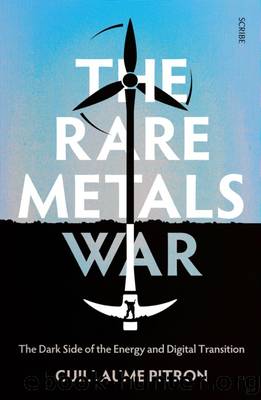The Rare Metals War by Guillaume Pitron

Author:Guillaume Pitron
Language: eng
Format: epub
Tags: NAT010000, POL062000, TEC010000, POL068000, TEC031010, TEC008000, TEC031000, TEC021030, TEC023000, ARC018000, NAT030000, TEC018000
Publisher: Scribe Publications Pty Ltd
Published: 2020-08-03T16:00:00+00:00
CHAPTER SEVEN
The race for precision-guided missiles
HOLLYWOOD HAS TAKEN A FERVENT INTEREST IN RARE EARTHS. AND RIGHTLY so: with plots featuring rare resources as indispensable as oil, the threat from China, and the survival of high-tech industries, it’s blockbuster material. This certainly wasn’t lost on the screenwriters of House of Cards, the hit television series about Frank Underwood (played by Kevin Spacey), an American politician who ruthlessly climbs his way to power in the White House. Rare metals are woven into the storyline in the second season, which bears a few similarities with reality.
In one episode, China uses its 95 per cent monopoly of the global production of samarium-149 — portrayed as a very rare metal that is indispensable to the operation of American nuclear reactors — to make the US pay a hefty price for the resource.1 Electricity prices become prohibitive for consumers, and Washington is plunged into political disarray. On Frank Underwood’s suggestion, the US decides to bypass the Chinese monopoly by buying samarium through a third party. This forces the Chinese, says the protagonist, ‘to lower [their prices] to keep a direct flow with us. We stockpile samarium for defence purposes … and quietly sell off what we don’t need to our friends …’
For the Pentagon, there is nothing new about stockpiling rare metals needed for the country’s defence as vital components of its war arsenal: tanks, destroyers, radars, smart bombs, antipersonnel mines, night-vision equipment, sonars, or the new laser weapons already tested in the Persian Gulf.2
More pressing still is the growing strategic importance of these resources as the threat of cyber warfare escalates. Indeed, twenty-first-century warfare is taking place on more and more fronts: belligerents strike not only on land, but in the air, in space, in cyberspace, and through media channels by seeking to wipe out the enemy’s communication channels, control images, rewrite history, and manipulate opinions. Warfare has moved from the ground to the stratospheres of electronic, media, and virtual wars, with rare metal–hungry servers, drones, radar aircraft, constellations of satellites, and space launchers as arsenal.3 The further away we move from the battlefield, the deeper we need to dig below it.
In terms of physical volumes, armies do not need a great deal of rare metals. According to one expert, the US defence industry imports a total of 200 tonnes of magnets every year — just 0.25 per cent of global production.4 A London analyst reckoned that the rare earths required to meet US defence needs for three years could fit into a single backpack.5 Yet the world’s powerhouse, whose military under Donald Trump was expected to monopolise US$738 billion of the US budget in 2020, would be cut down to size should these few packages of rare metals not make it to the arms factories.6
Download
This site does not store any files on its server. We only index and link to content provided by other sites. Please contact the content providers to delete copyright contents if any and email us, we'll remove relevant links or contents immediately.
| Automotive | Engineering |
| Transportation |
Whiskies Galore by Ian Buxton(40331)
Introduction to Aircraft Design (Cambridge Aerospace Series) by John P. Fielding(32338)
Small Unmanned Fixed-wing Aircraft Design by Andrew J. Keane Andras Sobester James P. Scanlan & András Sóbester & James P. Scanlan(32141)
Craft Beer for the Homebrewer by Michael Agnew(17446)
Turbulence by E. J. Noyes(7039)
The Complete Stick Figure Physics Tutorials by Allen Sarah(6638)
Kaplan MCAT General Chemistry Review by Kaplan(6053)
The Thirst by Nesbo Jo(5785)
Bad Blood by John Carreyrou(5769)
Learning SQL by Alan Beaulieu(5411)
Weapons of Math Destruction by Cathy O'Neil(5036)
Man-made Catastrophes and Risk Information Concealment by Dmitry Chernov & Didier Sornette(4735)
iGen by Jean M. Twenge(4702)
Digital Minimalism by Cal Newport;(4540)
Life 3.0: Being Human in the Age of Artificial Intelligence by Tegmark Max(4507)
Audition by Ryu Murakami(4099)
1,001 ASVAB Practice Questions For Dummies by Powers Rod(4038)
Electronic Devices & Circuits by Jacob Millman & Christos C. Halkias(4027)
Pale Blue Dot by Carl Sagan(4001)
